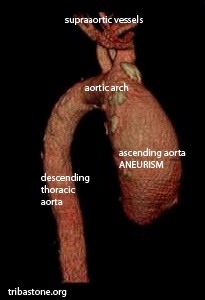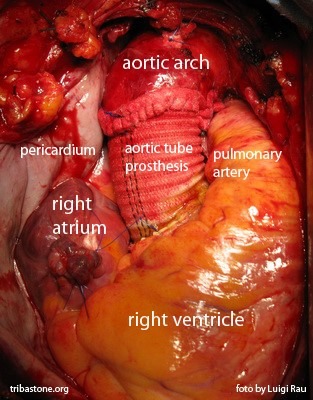Aortic aneurysm is the dilation of the Aorta in its various sections, Ascending, Arch, Descending Thoracic, Abdominal. These portions of the aorta may be affected individually or in combination. The type of treatment depends on the trait or traits of the aorta involved.
 The nature of this disease is usually atherosclerotic or degenerative, sometimes linked to connective tissue diseases. The presence of aortic aneurysm usually doesn’t give any symptoms until it comes to rupture or dissection until it comes with a dramatic clinical event that normally causes the patient’s death.
The nature of this disease is usually atherosclerotic or degenerative, sometimes linked to connective tissue diseases. The presence of aortic aneurysm usually doesn’t give any symptoms until it comes to rupture or dissection until it comes with a dramatic clinical event that normally causes the patient’s death.
In the ‘lucky’ cases, the diagnosis is made occasionally by means of a simple chest x-ray, with an echocardiographic examination, a CT scan of the thorax, or a Nuclear Magnetic Resonance performed for other reasons.
Cigarette smoke and hypertension may contribute to the weakening of the aortic wall and therefore to dilatation. The normal diameter of the ascending aorta in the average person is about 3 centimeters.
When the diameter exceeds the normal values, it is called dilatation, if we reach 5 – 5.5 cm we talk about aneurysm and the risk of rupture increases with the diameter.
Generally the treatment to the surgical replacement of the aorta is when the diameter reaches or exceeds 5.5 cm or in the case of aortic bicuspidia or Marfan Syndrome (syndrome of genetic origin of the connective tissue) the limit for surgery is lowered at 5 cm. The rapid growth of the aneurysm diameter (> 1 cm in a year) also suggests the surgical treatment. Beyond these numbers the risk of aortic dissection (breakage of the wall by fixation) is very high and with it the risk for the patient’s life.
For values below the thresholds described, it is recommended to evaluate the increase in diameter over time by means of angio-CT examination with contrast (more precise in size) or traditional (trans-thoracic) echocardiographic examination when the affected section is the ascending aorta.
The treatment of the ascending Aorta aneurysm is surgical. If aortic valve disease is concomitant, it will be necessary to treat both with other types of surgical treatments that we will not write about.
 The single replacement of the aneurysmatic section of the ascending aorta is performed in extracorporeal circulation. The diseased portion of aorta is resected just above the aortic valve and coronary ostia and before the aortic arch.
The single replacement of the aneurysmatic section of the ascending aorta is performed in extracorporeal circulation. The diseased portion of aorta is resected just above the aortic valve and coronary ostia and before the aortic arch.
A prosthetic tube of special material (dacron) of the normal aortic diameter is sutured instead of the resected section. Sometimes it is necessary to reinforce the end of the patient’s aorta (weakened by dilation) with a teflon band along its circumference, as can be clearly seen from the photo when the operation is completed. The prosthetic tube will be the new Ascending Aorta of the patient.

